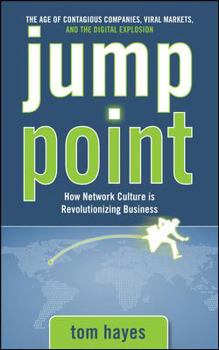Jump Point: How Network Culture Is Revolutionizing Business
Plug into the nonstop global economy of billion-selling products and trillion-dollar markets The Web 3.0 world of "pandemic economics" is a new economy that will function outside the traditional laws... This description may be from another edition of this product.
Format:Hardcover
Language:English
ISBN:007154562X
ISBN13:9780071545624
Release Date:February 2008
Publisher:McGraw-Hill Education
Length:257 Pages
Weight:1.10 lbs.
Dimensions:1.0" x 6.0" x 9.3"
Customer Reviews
4 ratings
Good book on an interesting subject
Published by Thriftbooks.com User , 14 years ago
This is a must read for any IT professional and most other business people if they want to see what might be coming in the near future.
Invaluable Insights
Published by Thriftbooks.com User , 14 years ago
Very important book for those looking for insights as to how the business environment is/might/will continue to change - especially if the trend towards globalization becomes more difficult as a result of the ongoing global economic crisis (David M. Smick: The World Is Curved). One very important piece of the global puzzle.
Answer after the Jump...
Published by Thriftbooks.com User , 15 years ago
At the close of Tom Hayes' "Jump Point: How Network Culture is Revolutionizing Business," the author enigmatically asks "Is the Jump Point the opening of a portal to a new Renaissance?" The answer? Apparently that comes after the Jump. Hayes starts off, though, by sounding the alarm. He forecasts that the next Jump Point, or turning point in human experience, will happen when the web welcomes its third billionth user. Three billion is roughly the size of the global workforce. And that moment when the global workforce is online and everything we think we know about conducting business will be upended is racing towards us with an ETA of 2011. According to Hayes, Jump Points have occurred throughout history whenever technology, economics, and culture converge to produce transformational change. It's not usually apparent in the moment, but in retrospect this moment looks like a sudden, non-linear growth surge in the adoption of a particular technology. He takes us through a fascinating leap across historical Jump Points: the creation of first organized cosmopolitan city-state Catal Huyuk, the manufacture of personal timepieces in Italy, the use of steam engine technology in the textile mills of Massachusetts. Hayes carefully differentiates these Jump Points from the invention of new technologies: the Jump Point is when the impact of the application of, integration of, or widespread adoption of a technology occurs, and it can come months, years, a century after the technological invention, or trigger. Hayes doesn't project an evolutionary shift or a gradual transition from the world as we know it to the future post-Jump state, or The Next Curve, as he puts it. He sees the Jump Point as a clash, two states occurring simultaneously and in direct conflict with one another (past tense and the future tense). The impending change will be on a grand, worldwide scale, a revolution of business and society, a major disruption of the world as we know it, and sudden, dire global upheaval. He references a broad array of supporting sources, from Clay Christensen's Disruptive Innovation to Albert Einstein's Theory of Relativity, in building a case for his hypothesis. But, paradoxically, it may be sudden, dire global upheaval that we don't notice. You won't know it when you see it, he seems to say, you'll need to take a long look back to recognize that momentous inflection point. I had a bit of trouble holding onto these two thoughts at once: a desire to fasten my seatbelt for a Jump I may not see or feel. After making every effort to scare the pants off the reader with the idea of three billion people - one billion who "may not be aware of what toilet paper is" - joining our trusted community, Hayes settles in to outline the Jump itself in Part Two. Or more accurately, the environment in which the the jump will occur. He takes a long, thorough look back at the technological advances and cultural environment leading up to our impending J
Insightful description of business-consumer interaction in the near-future
Published by Thriftbooks.com User , 16 years ago
Ever wonder what the interaction between business and consumers will be like in the not-too-distant future? (Hint: it probably won't include the singing cereal box of the movie Minority Report.) Author Tom Hayes thinks we're in the first steps of a massive cultural change, as fundamental as The Industrial Revolution. Inter-connectivity. You can see it beginning now with the success of social networking sites, and retailer websites like this one that allow for user reviews. A major hallmark of the future will be a battle for the consumer's attention, with the winner going to those businesses whom the consumer trusts. (Out with TV pitchmen and in with friends' recommendations.) Those businesses that allow consumers to mashup their own products will leave behind those that insist on strict intellectual property rights. You can see a lot where the future is going by just looking around, by extrapolating trends, but Hayes puts it all together into a cohesive whole. This is a must-read book for anyone, businessperson or consumer, who wants to understand where society is going. And Hayes thinks we'll be there soon -- predicting 2011 as the point where there'll be 3 billion people world-wide connected to the Internet. I gave the book 5 stars not because it was perfect -- I think Hayes's enthusiasm sometimes makes him jump to conclusions -- but because there are so many ideas and observations here that it would take ages to put something like this together from other sources. And it's well-written, in a light, breezy style, that kept my attention throughout. Well-done!





